
The 2008 edition of the Marble Institute of America’s “Quarry Tours and More” seminar took place from March 19 to 20 in Austin, TX. The trip included a tour of Cold Spring Granite Co.’s Marble Falls, TX, operation.
After two successful runs last year, the Marble Institute of America (MIA) set out on another “Quarry Tours and More” expedition in March 2008 - this time visiting several of the many granite and limestone sites in Texas. The two-day trip, which was held on Wednesday, March 19, and Thursday, March 20, was attended by a group of industry professionals from across the U.S. who were looking forward to learning more about the quarrying and fabrication processes in the southwest region. Additionally, participants had the opportunity to witness the carving skills of some incredibly talented sculptors at their shop in Florence, TX.
Local event partners who opened their doors and welcomed the group to their facilities included Architectural Granite & Marble, Cold Spring Granite Co., Continental Cut Stone, Texas Carved Stone and Texas Quarries. The MIA also attributes the success of its tour to the support of its strategic partners: Alpha Professional Tools® of Oakland, NJ; Aqua Mix Inc. of Corona, CA; ETemplateTM Systems of Raleigh, NC; GranQuartz of Tucker, GA; Laser Products Industries of Romeoville, IL; Marmo Machinery USA of Southfield, MI; Park Industries of St. Cloud, MN; Schechner Lifson Corp. of Summit, NJ; and Water Treatment Technologies of Hampton, NH.
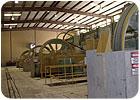
The company’s fabrication facility is located on the same site as its Sunset Red quarry, which was opened in 1882 to supply granite to the Texas State Capitol building in Austin.
Linked to Texan history
The first day of the tour began with a visit to Cold Spring Granite Co.’s Sunset Red quarry in Marble Falls, TX, which holds a great deal of historical value. While the company is headquartered in Cold Spring, MN, the site in Texas was opened to supply granite to the State Capitol building in Austin, which was originally designed by Elijah Myers and constructed from 1882 to 1888. Today, this site is one of seven quarries in Texas owned by Cold Spring Granite Co.“We have been quarrying for about 150 years,” said Mike Clark of Cold Spring Granite Co., adding that the Marble Falls site operates five days a week, year round. “The material is mostly used for monuments and structural [projects]. We’ve done a lot of state buildings.”
According to Quarry Manager Leonard Moore, the quarry produces approximately 400,000 cubic feet annually, with a 25% yield. “Most of the blocks that we pull out of here weigh about 40,000 pounds,” he said. “This location is [also] a blockyard for our other quarries.”
Moore went on to explain that the extraction method involves quarry workers drilling between 12 to 14 feet deep into a wall and about a foot a part. They then use diamond wire to cut the wall out. “The new diamond wire process is really quiet, and there is no dust,” he said. “It also doesn’t fragment the rock as much.”
In addition to the quarry, the Marble Falls operation also includes a large fabrication plant, which houses an extensive range of machinery. One area of the plant is designated for countertop fabrication. In total, the company produces eight to 10 kitchens per week. “We import slabs for our countertop division,” explained Clark. “It gives people a choice of what they want.”
The Marble Falls location is also equipped with four Barsanti gangsaws and a multiple diamond wire saw, which the company developed itself, according to Clark. The saw is equipped with 10 wires.
Just down the road from Cold Spring Granite Co.’s quarry and fabrication facility is the company’s showroom, which is called “Granite Mountain.” After touring the quarry and plant, the group stopped at the showroom for a lunch hosted by the company.

After the visit to Cold Spring Granite Co.’s plant and quarry, the company hosted a lunch for the group at its “Granite Mountain” showroom. The design center displayed a number of stone and tile products, including this Texas Pearl granite countertop - featuring a honed finish and thickness of 2 inches.
Visiting an historic landmark
Once lunch was over, the group was back on the bus and on its way to the Texas State Capitol building in Austin. Dating back to the late 1880s, the exterior facade features Sunset Red granite - the same material that participants saw quarried and processed earlier that morning.The building, which was completed in 1888 as the winning design from a national competition, is a Renaissance Revival style based on the architecture of 15th-century Italy. It is characterized by classical orders, round arches and symmetrical composition. Funding for the construction of the State Capitol was generated by selling approximately 3 million acres of land in the Texas Panhandle.
In 1970, the building was placed on the National Register of Historic Places. It was also designated a National Historic Landmark in 1986 for its “significant contribution to American history,” according to a statement on the Texas Capitol’s Web site.
During its visit to the historic landmark, the MIA group participated in a private tour of the building. It was pointed out that the Texas Capitol is the largest in gross square footage of all state capitols, and it is second in total size only to the National Capitol in Washington, DC. Additionally, the Texas Capitol is 15 feet taller than the National Capitol.
In the 1990s, several renovation and restoration projects were completed to improve the condition of the Texas Capitol and its surrounding landscape. A $75 million underground Capitol Expansion was completed to the north in 1993, which doubled the square footage available to the Capitol occupants and provided better functionality. Two years later, an extensive interior and exterior restoration of the original building was completed - totaling approximately $98 million. And to further enhance the look of the property, the park-like landscape surrounding the Capitol building was renovated and restored in 1997 for $8 million.
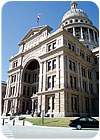
The group was then taken to the Texas State Capitol to witness the extensive use of Sunset Red granite on the building’s exterior facade.
A welcoming reception
After the visit to the Texas State Capitol building concluded, the group proceeded to a cocktail reception hosted by Architectural Granite & Marble Inc. at the company’s new warehouse in Austin. “This is our new campus, and we are pretty proud of it,” said owner Jack Seiders, adding that the facility was built to house the company’s inventory of tiles and slabs.While Austin is the home base for Architectural Granite & Marble, it also has branch offices in Birmingham, AL; Nashville, TN; Oklahoma City, OK; and San Antonio, TX. The company’s strategically placed locations allows it to successfully service its nationwide customer base, Seiders told the group.
While sipping on cocktails and eating hors d’oeuvres, group members had the opportunity to chat with Seiders, his wife, Peggy, and their two sons, Chad and Rick, to learn more about their business.
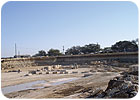
Jack Seiders, his wife, Peggy, and their two sons, Chad and Rick, of Architectural Granite & Marble, Inc. welcomed the group with a cocktail reception at the company’s new warehouse in Austin.
Touring a limestone quarry
The second day of the tour began with a trip to RLF Salado Quarries in Florence, TX. The group was greeted by co-owner Tommy Edwards, who explained that the company was started in 1999.“We are working the Georgetown Formation,” said Edwards. “We basically produce three brands of stone - white, cream and gold.” He went on to explain that the top layer is gold, while the bottom two layers are a cream-colored variety of limestone. There are then six layers of white-colored limestone in between.
“Six years ago, I couldn’t sell a gold or cream rock,” said Edwards. “Now everyone wants them. We are stacking white blocks to get them out of the way. We are busy right now more than we have ever been.”
While at RLF Salado Quarries, the group had the chance to wander around the site to observe limestone blocks being sawn from the ground as well as watching blocks being processed. “A few years ago, I started out with 60 acres,” Edwards explained. “Now I have acquired 320 acres and another 60 acres across the way. I have plenty of stone here. We can produce 600 tons of material a day.”
Primarily, RLF Salado Quarries supplies limestone for custom homes and commercial buildings, Edwards told the group. A total of 50% of material processed is products that are shipped on pallets, while the other half are blocks that are sold wholesale.
“Our thin stone veneer is doing really well,” said Edwards. Current work includes the Ritz Carlton in the Bahamas and a large project in California.
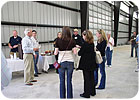
The second day of the tour began with a trip to RLF Salado Quarries in Florence, TX. “We are working the Georgetown Formation,” said co-founder Tommy Edwards. “We basically produce three brands of stone - white, cream and gold.”
Observing limestone processing
Just down the road from RLF Salado Quarries is Continental Cut Stone - a company that has been fabricating limestone since 1987. Tom Estes, General Manager, and Debbie Bennett, Account Manager, welcomed the group and showed them around the shop.The company owns a Lueders limestone quarry near the Abilene area of Texas, and it processes all of its stone at its location in Florence. “We work in six different types of limestone - five are from Texas,” said Estes. “The roughback Lueders is probably the most popular in the country right now. We get calls [for it] every day.”
In addition to Lueders limestone, other Texas limestone varieties supplied by Continental Cut Stone include Cream limestone, Shell limestone, West Texas Cream limestone and Hadrian limestone. The company also carries some Indiana limestone.
“Our niche is the upper high-end custom market,” said Estes. “Our customers tend to be contractors and masonry contractors. There are also a few architects that we work with directly.”
Although the majority of Continental Cut Stone’s work is for the residential market, the company also does some commercial projects. At the time of the MIA’s “Quarry Tours and More” visit, the company was fabricating pieces for the Air Force Museum in Amarillo, TX.
While visiting Continental Cut Stone, those on the tour had the opportunity to watch the company’s skilled workers carve detailed limestone pieces. The shop was equipped with planers for smoothing limestone slabs and ensuring that they are all consistent in size as well as a machine that is used to make balustrades.
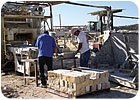
Some workers on site at RLF Salado Quarries used tools to chisel the limestone pieces by hand.
A showcase of hand-craftsmanship
Another recognized facility for stone craftsmanship in the area is Texas Carved Stone, also of Florence, TX. The company, which was started by Bob Ragan and Mary Condon in 1987, consists of a group of highly skilled artisans that specialize in architectural carvings in limestone. All of its raw material is purchased from Continental Cut Stone.Those on the MIA tour were fortunate enough to spend some time at Texas Carved Stone’s facility, watching the talented group of craftsmen sculpt blocks of limestone into intricately detailed works of art.
As founding members of the Stone Carvers Guild, a group of independent-working professional carvers throughout the U.S., the owners are careful in their selection of employees. Condon explained that in the beginning, it was more challenging to find skilled artisans, but now that the company has built a reputable name for itself, sculptors are coming to them.
“We are one of the largest carver shops in the country,” she said. “Now they seek us out. One [carver] came down from Philadelphia, who had studied in London for two years. We also find people through the Guild.”
In addition to watching the carvers in action, the MIA group also had the opportunity to walk through the company’s European stone garden. “About three or four years ago, Bob said that we are going to do this,” said Condon. “He designed these [sculptures] all from boneyard material at Continental Cut Stone.”
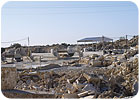
Also at the quarry site were large block cutters, which were manufactured by Park Industries of St. Cloud, MN.
A Texas limestone mainstay
The MIA’s “Quarry Tours and More” tour concluded with a visit to Texas Quarries in Cedar Park, TX, where the group was greeted by Buddy Brizendine, Sales Manager, and Robert Copeland, Production Manager. The company treated the group to a Texas-style barbecue before leading them on a tour of the mill.With two quarries and a large-scale fabrication mill, Texas Quarries - owned by Acme Brick and a subsidiary of Berkshire-Hathaway - has been producing Cordova and Lueders limestone since 1929.
“Our Armadillo quarry is where we quarry Cordova Cream,” said Copeland, who has been with the company for 23 years. “We quarry the ‘White Stone Lens’ on top of the Edwards Formation.”
Additionally, Cordova Shell Stone is extracted from the Armadillo site. “We pull off about 6 to 8 feet of [Cordova] Cream and then there is 4 feet of Shell [Stone] on the bottom,” said Copeland, as he pointed out a block of the material to the group.
The Production Manager went on to explain that the quarry that produces Lueders limestone sits in the Abilene area of Texas. “Lueders is small scale compared to our Cordova Cream,” said Copeland, adding that one ledge of the Lueders quarry produces a very unique material, which Texas Quarries calls Sea Trace limestone.
Copeland showed those on the tour a piece of the material, and he explained that the fossilization in this stone, which is a random crisscross pattern, was formed by a type of ancient worm called “Planolites” and a shrimp called “Thalassinoides.”
While walking through the mill, group members also had the opportunity to see several large belt saws cutting through limestone blocks measuring 8 to 9 feet as well as workers using hand tools to craft detailed architectural elements and signs such as one being made for the Liberty Hill Panthers high school football team, which captured the AAA Division II Football State Championship in 2007.
After receiving a warm farewell from Brizendine, Copeland and the rest of the staff at Texas Quarries, the group re-boarded the bus, which signaled the end of the trip. With another successful excursion under its belt, the MIA plans to host another “Quarry Tours and More” tour in 2009 to a region not yet decided. For a complete list of the MIA’s calendar of events, visit www.marble-institute.com.
